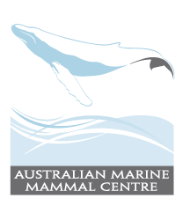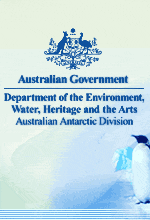Many whale and dolphin populations are at risk of decline and extinction due to several past and present anthropogenic activities, including whaling, fisheries, pollution, coastal development, and climate change. Historical whaling, for example, has reduced some species to the brink of extinction, with some populations showing signs of recovery while others do not. By-catch, particularly of small cetaceans, in fisheries is also one of the major threats to these animals worldwide. This program uses molecular ecological approaches to investigate the size, structure, phylogeographic patterns and evolutionary relationships of cetacean populations, subspecies and species. Study animals include blue whales, sperm whales, bottlenose dolphins and common dolphins.
Program coordinator: Dr Luciana Möller
Investigators and collaborators: Prof Luciano Beheregaray, Prof Rob Harcourt, Dr Kerstin Bilgmann, Dr Guido Parra, Ana Amaral, Catherine Attard, Nikki Zanardo.
– Möller LM (2012). Sociogenetic structure, kin associations and bonding in delphinids. Molecular Ecology doi: 10.1111/j.1365-294X.2011.05405.x.
– Amaral AR, Jackson JA, Möller LM, Beheregaray LB, Coelho MM (2012) Species tree of a recent radiation: the subfamily Delphininae (Cetacea, Mammalia). Molecular Phylogenetics and Evolution dx.doi.org/10.1016/j.ympev.2012.04.004
– Steckenreuter A, Harcourt R, Möller LM (2012). Are Speed Restriction Zones an effective management tool for minimising impacts of boats on dolphins in an Australian marine park? Journal of Marine Policy 36: 258-264.
– Steckenreuter, A., Harcourt, R., Möller, L. (2011). Distance does matter: close approaches by boats impede feeding and resting behaviour of Indo-Pacific bottlenose dolphins. Wildlife Research 38: 455-463.
– Amaral AR, Beheregaray LB, Bilgmann K, Boutov D, Freitas L, Robertson KM, Sequeira M, Stockin KA, Coelho MM, Möller LM (2012). Seascape genetics of a globally distributed, highly mobile marine mammal: the short-beaked common dolphin (genus Delphinus). PLoS One 7(2): e31482.
– Steckenreuter A, Harcourt R, Möller LM (2012). How does Australia’s largest dolphin-watching industry affect the behaviour of Indo-Pacific bottlenose dolphins? Journal of Environmental Management 97, 14-21.
– Bilgmann K, Möller LM, Harcourt RG, Kemper CM, Beheregaray LB (2011).The use of carcasses for the analysis of cetacean population genetic structure: a comparative study in two dolphin species. PLoS One 6(5): e20103.
– Amaral AR, Möller LM, Beheregaray LB, Coelho MM. Evolution of two reproductive proteins, ZP3 and PKDREJ, in Cetaceans (2011). Journal of Heredity 102: 275-282.
– Möller LM, Valdez FP, Allen SJ, Bilgmann K, Corrigan S, Beheregaray LB (2011). Fine-scale genetic structure in short-beaked common dolphins (Delphinus delphis) along the East Australian Current. Marine Biology 158: 113-126.
– Attard C, Beheregaray LB, Jenner C, Gill P, Jenner M, Morrice M, Bannister J, LeDuc R, Möller LM. (2010) Genetic diversity and structure of blue whales (Balaenoptera musculus) in Australian feeding aggregations. Conservation Genetics 11: 2437-2441.
– Wiszniewski J, Möller LM, Allen SJ, Beheregaray LB. (2010) Environmental and social influences on the genetic structure of bottlenose dolphins (Tursiops aduncus) in Southeastern Australia. Conservation Genetics 11: 1405-1419.
– Amaral AR, Silva MC, Möller LM, Beheregaray LB, Coelho MM (2010) Anonymous nuclear markers for cetacean species. Conservation Genetics 11: 1143-1146.
– Bilgmann K, Möller LM, Gales R, Harcourt R, Beheregaray LB (2009) Reply to “Clarifying the interpretation of Hamer et al. (2008) by Bilgmann et al. (2008)”. Animal Conservation 12: 289–290.
– Bilgmann K, Möller LM, Gales R, Harcourt R, Beheregaray LB. (2008) Common dolphins subject to fisheries impacts in Southern Australia are genetically differentiated: implications for conservation. Animal Conservation 11: 518-528.
– Möller L.M., Bilgmann K., Charlton K, Beheregaray L.B. (2008) Genetic evidence for a new species of bottlenose dolphin in southern Australia. Molecular Phylogenetics and Evolution 49: 674-681
– Möller LM, Wiszniewski J, Allen SJ, Beheregaray LB (2007) Habitat type promotes rapid and localized genetic differentiation in dolphins. Marine and Freshwater Research 58: 640-648
– Bilgmann K, Möller LM, Harcourt R, Beheregaray LB (2007) Genetic differentiation in bottlenose dolphins from South Australia: an association with local oceanography and coastal geography. Marine Ecology Progress Series341: 265-276
– Bilgmann, K.; O. Griffths; S.J. Allen; L.M. Möller (2007) A biopsy pole system for bow-riding dolphins: sampling success, behavioral responses and test for sampling bias. Marine Mammal Science 23: 218–225.
– Möller, L.M. and L.B. Beheregaray (2004). Genetic evidence for sex-biased dispersal in resident bottlenose dolphins (Tursiops aduncus). Molecular Ecology 13: 1607-1612
– Möller, L.M.; S.J. Allen and R.G. Harcourt (2002). Group characteristics, site fidelity and abundance of bottlenose dolphins (Tursiops aduncus) in Jervis Bay and Port Stephens, southeastern Australia. Australian Mammalogy 24: 11-21.
– Möller, L.M. and L.B. Beheregaray (2001) Coastal bottlenose dolphins from southeastern Australia are Tursiops aduncus according to sequences of the mitochondrial DNA control region. Marine Mammal Science 17: 249-263 .



